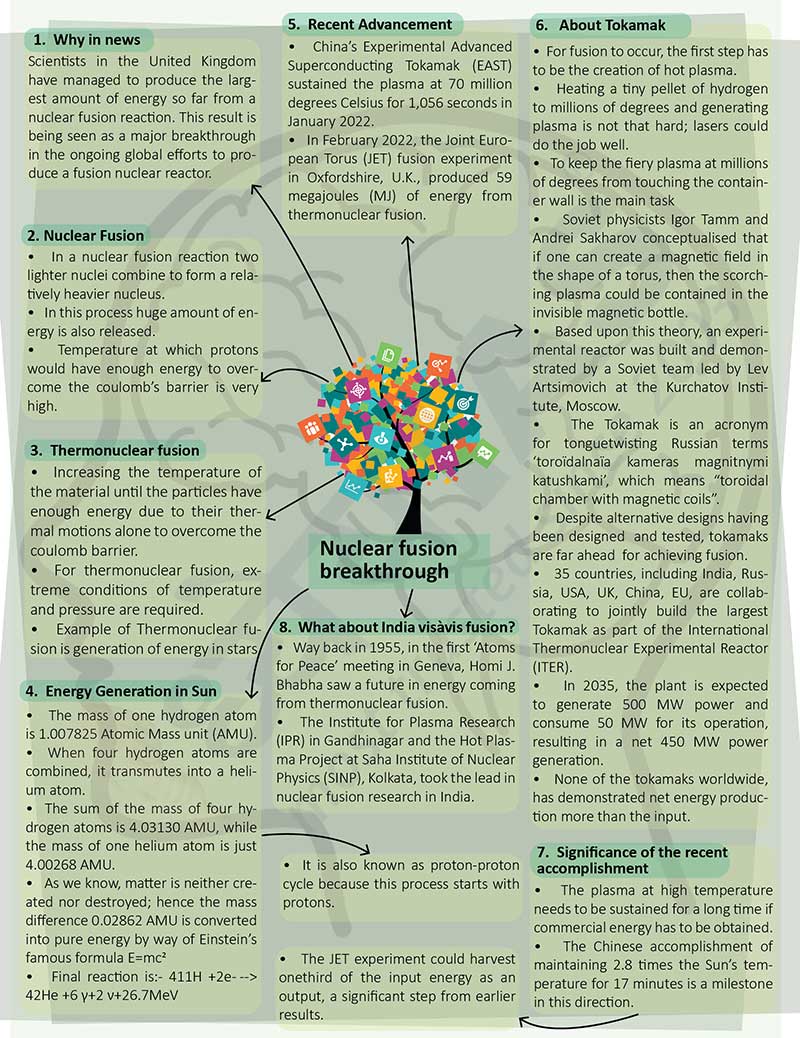Brain-booster
/
27 Mar 2022
Brain Booster for UPSC & State PCS Examination (Topic: Nuclear fusion breakthrough)

Why in news?
- Scientists in the United Kingdom have managed to produce the largest
amount of energy so far from a nuclear fusion reaction. This result is being
seen as a major breakthrough in the ongoing global efforts to produce a
fusion nuclear reactor.
Nuclear Fusion
- In a nuclear fusion reaction two lighter nuclei combine to form a
relatively heavier nucleus.
- In this process huge amount of energy is also released.
- Temperature at which protons would have enough energy to overcome the
coulomb’s barrier is very high.
Thermonuclear fusion
- Increasing the temperature of the material until the particles have
enough energy due to their thermal motions alone to overcome the coulomb
barrier.
- For thermonuclear fusion, extreme conditions of temperature and pressure
are required.
- Example of Thermonuclear fusion is generation of energy in stars.
Energy Generation in Sun
- The mass of one hydrogen atom is 1.007825 Atomic Mass unit (AMU).
- When four hydrogen atoms are combined, it transmutes into a helium atom.
- The sum of the mass of four hydrogen atoms is 4.03130 AMU, while the
mass of one helium atom is just 4.00268 AMU.
- As we know, matter is neither created nor destroyed; hence the mass
difference 0.02862 AMU is converted into pure energy by way of Einstein’s
famous formula E=mc2
- Final reaction is:- 411H +2e- --> 42He +6 γ+2 ν+26.7MeV
- It is also known as proton-proton cycle because this process starts with
protons.
Recent Advancement
- China’s Experimental Advanced Superconducting Tokamak (EAST) sustained
the plasma at 70 million degrees Celsius for 1,056 seconds in January 2022.
- In February 2022, the Joint European Torus (JET) fusion experiment in
Oxfordshire, U.K., produced 59 megajoules (MJ) of energy from thermonuclear
fusion.
About Tokamak
- For fusion to occur, the first step has to be the creation of hot
plasma.
- Heating a tiny pellet of hydrogen to millions of degrees and generating
plasma is not that hard; lasers could do the job well.
- To keep the fiery plasma at millions of degrees from touching the
container wall is the main task
- Soviet physicists Igor Tamm and Andrei Sakharov conceptualised that if
one can create a magnetic field in the shape of a torus, then the scorching
plasma could be contained in the invisible magnetic bottle.
- Based upon this theory, an experimental reactor was built and
demonstrated by a Soviet team led by Lev Artsimovich at the Kurchatov
Institute, Moscow.
- The Tokamak is an acronym for tonguetwisting Russian terms ‘toroïdalnaïa
kameras magnitnymi katushkami’, which means “toroidal chamber with magnetic
coils”.
- Despite alternative designs having been designed and tested, tokamaks
are far ahead for achieving fusion.
- 35 countries, including India, Russia, USA, UK, China, EU, are
collaborating to jointly build the largest Tokamak as part of the
International Thermonuclear Experimental Reactor (ITER).
- In 2035, the plant is expected to generate 500 MW power and consume 50
MW for its operation, resulting in a net 450 MW power generation.
- None of the tokamaks worldwide, has demonstrated net energy production
more than the input.
Significance of the recent accomplishment
- The plasma at high temperature needs to be sustained for a long time if
commercial energy has to be obtained.
- The Chinese accomplishment of maintaining 2.8 times the Sun’s
temperature for 17 minutes is a milestone in this direction.
- The JET experiment could harvest onethird of the input energy as an
output, a significant step from earlier results.







